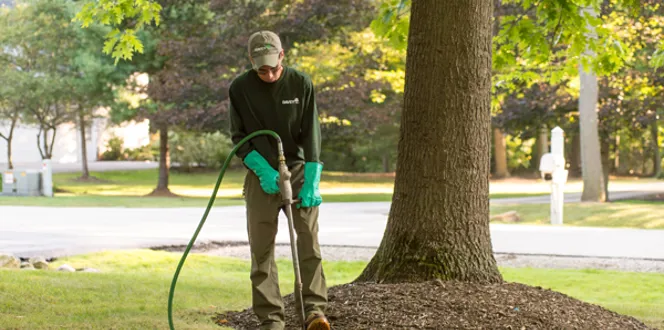Your plants can never perform their best in your home landscape if they aren’t growing in great soil.
There are a variety of things that can inhibit your plants from being able to take advantage of a soil even if it is a rich environment full of adequate nutrients, plentiful organic matter, and a balanced pH. One of them is soil holding too much water.
While over-watering or a broken irrigation system can surely cause waterlogged soil, other reasons for excess water in your soil could be soil type and terrain, heavy rains, flooding, or being located in a high water table. For instance, high clay soils tend to have more drainage issues than sandy soils. They can also become more easily compacted, so air and nutrients don’t flow through them as well. This can cause your plants to suffer.
Let’s better understand what well-drained soil is and how to drain waterlogged ground so you can improve below ground conditions for your plants.
How Long Should It Take For Soil To Dry?
One part of understanding how to fix soggy soil is knowing how water performs in soil and how long it takes to dry.
These are some signs of a landscape without ideal drainage:
- You see large amounts of water flowing quickly over saturated soil, which can lead to erosion.
- You notice standing water after rain, indicating slow drainage.
- Your plant leaves are turning yellow then brown, signaling possible root suffocation and decline.
- You see root decay. Maybe a shrub was leaning and easily pulls out of your soil, for instance, revealing wet, shallow roots.
To test drainage in your site, Texas A&M University Extension recommends you dig a hole twelve inches deep and wide and fill it with water. If the water completely drains in less than three hours, drainage is excellent but may require only plants that can handle dry conditions. If the water takes between three and twelve hours to drain, this equates to about one inch per hour and is considered adequate. If the water takes more than twelve hours to drain, drainage is poor and the soil may need some correction or may require plants tolerant of wet conditions.
Soil Compaction & Drainage Issues
Compacted soil is also a problem which contributes to poor drainage.
Soil becomes compacted through years of foot and mower traffic. This compaction limits water and air movement around your tree roots. Roots may die or fail to grow, and the result is poor overall plant health and growth.
Ideal soil typically contains approximately 50% solid materials and 50% pore space that can be filled by air and water.
Poorly drained soils have much of that pore space filled with water for long periods of time, leaving little room for airflow. In compacted soil, solid materials pack into larger pore spaces, slowing down water drainage and air movement.
This can all lead to runoff, which is what happens when it rains and water runs off of hard soil surfaces instead of soaking into the ground. Excessive runoff can erode your landscape or wear down your garden soil. In addition to ensuring soil is draining properly, there are ways to collect and filter excess runoff on your landscape to reduce water pollution, including rain gardens.
How To Fix And Restore Waterlogged Soil
When it comes to how to restore soil drainage, the best solution is adding organic matter while breaking-up the soil.
When incorporated into your soil, organic matter in the form of humus, compost, peat moss, biochar or other options can provide the needed pore space. This lets air in, prevents clay particles from cementing themselves into solid masses so roots can grow more easily through your soil, releases nutrients, and promotes the growth of microorganisms. Organic matter can also be added to the surface (mulching), to improve surface infiltration, and to deep holes (vertical mulching), to improve deep drainage.
Choose The Right Plants
If your home landscape tends to naturally have waterlogged soil, you can also choose plants that more easily adapt to these conditions.
Plants that are good for wet areas will help soak up this additional moisture and will continue to thrive since they can handle wetter roots.
Maybe you have spots in your yard that tend to collect standing water or are located at the bottom of hills. Plants that can absorb more water will look good in your landscape and bring some much-needed color and texture to bare areas.
Some trees to consider include weeping willow (zones 6-8), white cedar (zones 4-8), and oriental arborvitae (zones 6-11). A few shrubs to try are red twig dogwood (zones 3-8), blue elderberry (zones 3-10), and American cranberry bush (zones 2-7). A couple of plants that can work in your yard include daylilies (zones 3-11), Japanese iris (zones 4-9), and primrose (zones 3-8). Check out our recommendations for more ideas of trees, shrubs, and plants that can work for your specific gardening zone.







